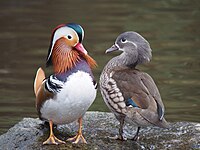
Photo from wikipedia
Although birds have genetically determined sex, the sex ratio has been reported to deviate from parity in several studies. Temperature-dependent sex determination, which is common in reptiles, is absent in… Click to show full abstract
Although birds have genetically determined sex, the sex ratio has been reported to deviate from parity in several studies. Temperature-dependent sex determination, which is common in reptiles, is absent in birds. However, females are able to adjust their investment into eggs according to the sex of the embryo, which may cause sex-specific embryonic mortality. Incubation temperature may also cause sex-biased embryonic mortality, and it may differentially affect the phenotype of male and female hatchlings. We aimed to investigate differences between male and female Mallard embryos regarding their egg size, mortality during incubation and hatchling phenotype in relation to incubation temperature. Mallard eggs were incubated under six constant incubation temperatures (ranging from 35.0 to 38.0 °C). Hatchlings were weighed, and their morphological traits were measured. We determined the sex of hatchlings and unhatched embryos by genetic analysis and found higher male embryonic mortality at 35.5 °C (44 males vs. 28 females) and a higher proportion of female hatchlings at 38 °C (24 males vs. 38 females); however, these results were not statistically significant. Our results suggest that Mallard females do not differentiate quantitatively between sexes during egg production. Male hatchlings were significantly larger but not heavier than females. The size difference between sexes was most pronounced at temperatures around 36 °C, which is the mean temperature of naturally incubated Mallard eggs.
Journal Title: Journal of thermal biology
Year Published: 2019
Link to full text (if available)
Share on Social Media: Sign Up to like & get
recommendations!